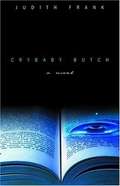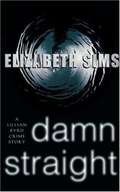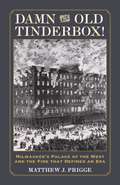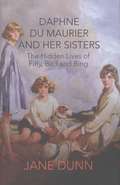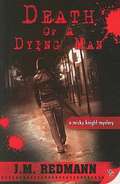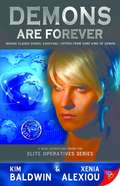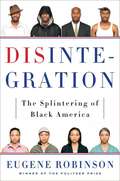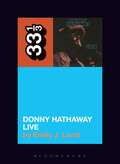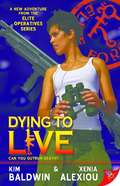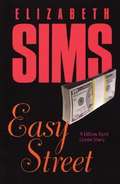- Table View
- List View
Crybaby Butch
by Judith FrankDrawing on her experience as an adult literacy tutor, Judith Frank's first novel traces the difficult and sometimes hilarious connection between two butches of different generations - a middle-class, thirty-something adult literacy teacher and her older, working-class student. With a disparate group of adult learners as the backdrop, Frank examines, with warmth and wit, the relationship between education and gender, class, and racial identity.
Damn Straight (Lillian Byrd Crime Story #2)
by Elizabeth SimsWhen a friend in crisis calls from California, Lillian jumps on a plane and wings her way from Detroit to Palm Springs--and danger. It's the long weekend of the Dinah Shore golf tournament, the wildest women's sporting event in the world, when thousands of lesbians descend on the desert community of Rancho Mirage and take over. At a pre-championship party, Lillian leaps into a slippery romance with a top LPGA star. But her superstar athlete has a secret: Someone is quietly terrorizing her. Lillian, eager to help, goes undercover as a high-profile reporter, an unhinged nun, and a professional caddie while uncovering layer after disturbing layer of the golfer's past. Finally, with violence erupting at every turn, Lillian uncovers her lover's ultimate horrifying secret--and it is not at all what she had guessed. With this new book, Elizabeth Sims presents another nail-biting thriller featuring her oh-so-human amateur detective. Damn Straight sizzles and zings and will have you laughing through your shivers.
Damn the Old Tinderbox!: Milwaukee's Palace of the West and the Fire That Defined An Era
by Matthew J. PriggeIn the dead of an unassuming January night in 1883, Milwaukee’s Newhall House hotel was set on fire. Two hours later, the building—once among the tallest in the nation—lay in ruins and more than seventy people were dead. It was a tragedy that brought global notice to Milwaukee, with daring escapes, unlikely rescues, and heart-wrenching tales of victims burned to death or killed as they leapt from the burning building. From the great horror emerged an even greater string of mysteries: Who had set the fire, and who was to blame for the staggering loss of life? The Newhall’s hard-luck barkeeper? A gentleman arsonist? What about the many other unexplained fires at the hotel? Had the Newhall’s management neglected fire safety to boost profits? Would the true number of victims ever be known?
Daphne Du Maurier and Her Sisters: The Hidden Lives of Piffy, Bird, and Bing
by Jane DunnCelebrated novelist Daphne Du Maurier and her sisters, eclipsed by her fame, are revealed in all their surprising complexity in this riveting new biography. The middle sister in a famous artistic dynasty, Daphne du Maurier is one of the master storytellers of our time, author of 'Rebecca,' 'Jamaica Inn,' 'My Cousin Rachel,' and short stories, 'Don't Look Now' and the terrifying 'The Birds,' among many. Her stories were made memorable by the iconic films they inspired, three of them classic Hitchcock chillers. But her sisters Angela and Jeanne, a writer and an artist of talent, had creative and romantic lives even more bold and unconventional than Daphne's own. In this group biography they are considered side by side, as they were in life, three sisters who grew up during the 20th century in the glamorous hothouse of a theatrical family dominated by a charismatic and powerful father. This family dynamic reveals the hidden lives of Piffy, Bird & Bing, full of social non-conformity, love, rivalry and compulsive make-believe, their lives as psychologically complex as a Daphne du Maurier novel.
Daphne du Maurier: The Secret Life of the Renowned Storyteller
by Margaret ForsterThe authorized biography of the author of Rebecca, a novel first published in 1938 and still a steady seller. Du Maurier was an intensely emotional and unconventional woman, and Forster draws on hitherto unpublished letters, including a cache of previously unknown love letters between Du Maurier and actress Gertrude Lawrence. Includes photos. Annotation copyright by Book News, Inc. , Portland, OR
Dare to Repair: A Do-It-Herself Guide to Fixing (Almost) Anything In The Home
by Julie Sussman Stephanie Glakas-TenetA repair guide written especially for women.
Daughters Of An Amber Noon
by Katherine V. ForrestThe lesbian classic Daughters of a Coral Dawn told the story of a group of pioneering women who disappeared from Earth and colonized the planet Maternas. But what became of the sisters they left behind? In this highly anticipated sequel, best-selling author Katherine V. Forrest describes an Earth beyond nightmare ruled by dictator Theo Zedera-known simply as Zed-whose weaponry is invincible. With ruthless determination he seeks the vanished women remaining on Unit Earth. Among these women is the leader of the Unity, the extraordinary Africa Contrera, Zed's childhood friend as well as his colleague and intellectual equal. As Africa struggles to build a world safe for women, she is haunted by her past - a time when she trusted Zed and shared with him the deadly knowledge he now uses to hunt her. What future can there be for the women who call themselves the Unity? How can they possibly conceal themselves from a world of savagery and a man who intends to find them at any cost? Just as she did 18 years ago, Katherine Forrest has created a brilliant, breathtaking, and romantic saga of a divided society and the rebels courageous enough to withstand a brutal new world.
Daughters of an Emerald Dusk
by Katherine V. ForrestSequel to Daughters of an Amber Noon; about a planet populated by only women.
Death by the Riverside (Micky Knight Mystery #1)
by J. M. RedmannP.I. Micky Knight is approached by a beautiful blond, who asks her to find a missing person. Knight thinks this will be a simple case, but it turns deadly, as she is forced to confront fears of both past and present. First in the Micky Knight series.
Death of a Dying Man (Micky Knight Mystery #5)
by J. M. RedmannFifth in the Mickey Knight mystery series based in New Orleans; lesbian detective.
Deaths of Jocasta (Micky Knight Mystery #2)
by J. M. RedmannLesbian detective story set in New Orleans.
Demons are Forever (Elite Operatives #5)
by Kim Baldwin Xenia AlexiouBehind closed doors, everyone suffers from some kind of demon. Veteran Elite Operative Landis "Chase" Coolidge's latest mission requires every bit of her considerable tracking skills because she has to locate a colleague kidnapped by a brilliant scientist responsible for the deaths of millions. Former op Phantom is along for the ride, desperate to find her missing lover. By day, Heather Snyder works in the New York fashion industry. But her secret life as a high-class call girl thrusts her into the middle of a global black market organ harvesting ring and draws the interest of the EOO. No stranger to the world of call girls, Chase revels in her latest assignment, until she discovers that Heather is the one woman who can change her roguish ways.
Diana: A Strange Autobiography
by Diana Frederics Julie AbrahamThis 1939 novel fits into a unique historical gap between the medical texts of the early part of the twentieth century and rare novels like Radclyffe Hall's The Well of Loneliness on one hand and the lesbian pulp fiction of the 1940s and 1950s on the other hand.
Disintegration: The Splintering of Black America
by Eugene RobinsonInstead of one black America, today there are four. There was a time when there were agreed-upon "black leaders," when there was a clear "black agenda," when we could talk confidently about "the state of black America"--but not anymore. -from Disintegration. The African American population in the United States has always been seen as a single entity: a "Black America" with unified interests and needs. In his groundbreaking book,Disintegration, Pulitzer-Prize winning columnist Eugene Robinson argues that over decades of desegregation, affirmative action, and immigration, the concept of Black America has shattered. Instead of one black America, now there are four: a Mainstream middle-class majority with a full ownership stake in American society; a large, Abandoned minority with less hope of escaping poverty and dysfunction than at any time since Reconstruction's crushing end; a small Transcendent elite with such enormous wealth, power, and influence that even white folks have to genuflect; and two newly Emergent groups--individuals of mixed-race heritage and communities of recent black immigrants--that make us wonder what "black" is even supposed to mean. Robinson shows that the four black Americas are increasingly distinct, separated by demography, geography, and psychology. They have different profiles, different mindsets, different hopes, fears, and dreams. What's more, these groups have become so distinct that they view each other with mistrust and apprehension. And yet all are reluctant to acknowledge division. Disintegration offers a new paradigm for understanding race in America, with implications both hopeful and dispiriting. It shines necessary light on debates about affirmative action, racial identity, and the ultimate question of whether the black community will endure.
Does Your Mama Know?: An Anthology of Black Lesbian Coming Out Stories
by Lisa C. Mooreshort stories
Don't Touch That Dial!: Radio Programming in American Life, 1920 - 1960
by J. MacDonaldFor those who loved it, as well as for those who missed it, this book brings to life old-time radio, which was often called a "theater of the mind." It is an entertaining and important history of radio programming and its role in shaping social values and thought in America.
Donny Hathaway Live (33 1/3 Ser. #117)
by Emily J. LordiIn January of 1979, the great soul artist Donny Hathaway fell fifteen stories from a window of Manhattan’s Essex House hotel in an alleged suicide. He was 33 years old and everyone he worked with called him a genius. Best known for “A Song for You,” “This Christmas,” and classic duets with Roberta Flack, Hathaway was a composer, pianist, and singer committed to exploring “music in its totality.” His velvet melisma and vibrant sincerity set him apart from other soul men of his era while influencing generations of singers and fans whose love affair with him continues to this day.
Dream Lover
by Lyn DenisonJo couldn't remember when the dreams began, but they always ended the same way - with her desperately reaching out for something just beyond her grasp. The dreams could easily be a metaphor for her own unfulfilled existence. Having given up all hope of love and happiness long ago, Jo now seeks only escape from the scattered remnants of a failed marriage and the dreadful apathy that seems to engulf her more and more each day. On an extended vacation, she hopes that a change of scenery will help her get on with her life. But never in her wildest dreams did she imagine that a chance meeting with an attractive stranger would lead to her first taste of real passion - on the lips of a woman with the strength and the desire to make all her dreams come true.
Dying to Live (Elite Operatives #4)
by Kim Baldwin Xenia AlexiouBritish socialite Zoe Anderson-Howe's pampered life is abruptly shattered when she's taken hostage by FARC guerrillas while on a business trip to Bogota. While her father struggles to come up with the ransom, she must endure hardships that test her both mentally and physically. Elite Operative Fetch has been living in the Colombian jungle for six months on a mission to infiltrate the FARC and orchestrate the rescue of western hostages. When Zoe is added to her assignment, Fetch's sense of duty must override the disdain she initially feels for the self-indulgent tabloid queen. The task of freeing Zoe gains new urgency when it appears she may be the key to stopping a mysterious new virus that is racing across the globe, killing indiscriminately. The support Fetch counted on is needed elsewhere. Can she get Zoe out of there on her own, and will that be enough to save the millions of lives in peril? Fourth in the romantic intrigue series: Elite Operatives
Easy Street (Lillian Byrd Crime Story #4)
by Elizabeth SimsHer old Caprice is convulsing through the last of its death throes, her pet rabbit and constant companion Todd ails, and as usual, Lillian Byrd is flat broke. For a few extra bucks she agrees to help an old friend renovate her house, but as fans of "Holy Hell", "Damn Straight", and "Lucky Stiff "have come to realize, nothing ever goes smoothly in the life of Lillian Byrd. By the end of the first day on the job there is a partially demolished wall, a mysterious stash of cash, and a dead body. And Lillian's attentions have been diverted by the appearance of a drop-dead gorgeous neighbor. Elizabeth Sims is the author of three previous books in the Lillian Byrd Crime Stories series: "Holy Hell", "Damn Straight", and "Lucky Stiff".
Either is Love
by Elisabeth CraiginFirst published 1937. After the death of her husband, the narrator re-reads the letters she had written him about her earlier intense love affair with another woman. This beautifully written "memoir" is an almost unequaled treatment of a lesbian romance.
